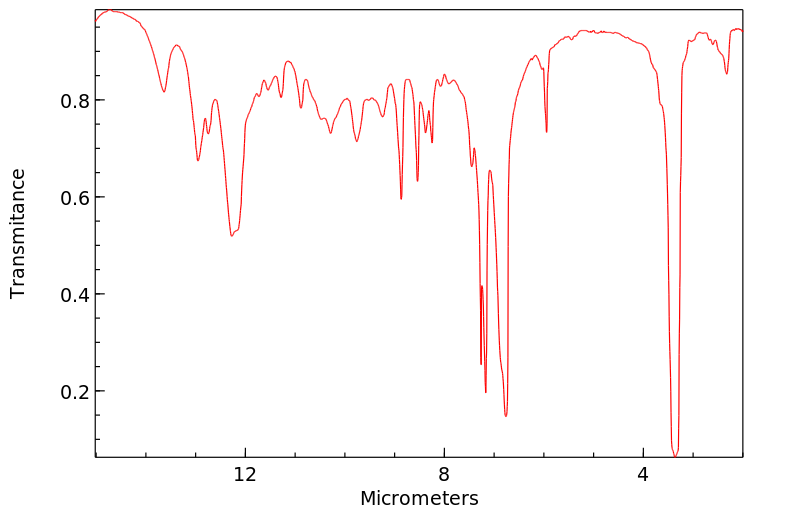(E)-3,7-dimethyloct-2-ene | 6874-06-2
中文名称
——
中文别名
——
英文名称
(E)-3,7-dimethyloct-2-ene
英文别名
3,7-dimethyloct-2-ene;2-Octene, 3,7-dimethyl-, (Z)-
CAS
6874-06-2
化学式
C10H20
mdl
——
分子量
140.269
InChiKey
ADGIRGGMVLTMJM-BJMVGYQFSA-N
BEILSTEIN
——
EINECS
——
-
物化性质
-
计算性质
-
ADMET
-
安全信息
-
SDS
-
制备方法与用途
-
上下游信息
-
文献信息
-
表征谱图
-
同类化合物
-
相关功能分类
-
相关结构分类
物化性质
-
沸点:163.0±7.0 °C(Predicted)
-
密度:0.748±0.06 g/cm3(Predicted)
-
保留指数:970
计算性质
-
辛醇/水分配系数(LogP):4.6
-
重原子数:10
-
可旋转键数:4
-
环数:0.0
-
sp3杂化的碳原子比例:0.8
-
拓扑面积:0
-
氢给体数:0
-
氢受体数:0
SDS
反应信息
-
作为反应物:描述:(E)-3,7-dimethyloct-2-ene 在 AD-mix β 、 三(五氟苯基)硼烷 、 水 作用下, 以 二氯甲烷 、 叔丁醇 为溶剂, 反应 24.0h, 生成 1-(((3R)-3,7-dimethyloctan-2-yl)oxy)-3,3,3-triethyl-1,1-diphenyldisiloxane参考文献:名称:未激活的1,2-二元醇通过协同立体转化机理进行催化还原Pinacol型重排摘要:内部人士的机会:通过使用简单的硼催化剂和两种硅烷(参见方案),开发了1,2-内部二醇催化的频哪醇型还原重排。该反应通过协同的立体反转机制发生,可用于通常不适合频哪醇类反应的几种底物支架,例如脂族仲-仲二醇,而无需进行预功能化。DOI:10.1002/anie.201704936
-
作为产物:描述:2,6-二甲基-2,4,6-辛三烯 在 poly-1,2,3-triazolyl ferrocenyl dendrimer-Pd nanoparticle 氢气 作用下, 以 甲醇 、 氯仿 为溶剂, 25.0 ℃ 、101.33 kPa 条件下, 生成 (E)-3,7-dimethyloct-2-ene 、 2,6-二甲基-2-辛烯参考文献:名称:“点击”树枝状聚合物:Pd(OAc)2的合成,氧化还原感测以及由含1,2,3-三唑的树枝状聚合物稳定的精确Pd纳米粒子的显着催化加氢活性。摘要:考虑到催化应用,已经合成了含有与PdII(OAc)2配位的1,2,3-三唑基配体的“点击”树枝状聚合物。这些树枝状化合物中的五个含有直接连接至三唑配体的二茂铁基末端,以监测通过循环伏安法引入树枝状聚合物中的PdII的数量。通过TEM证实,通过使用NaBH4或甲醇还原PdII-三唑树状大分子,可制得Pd纳米颗粒(PdNPs),可通过多个树状大分子(G0,DSN)或封装在树状大分子中(G1和G2:DEN)来稳定。相对于PAMAM-DEN(PAMAM =聚(酰胺基胺)),“点击” DSN和DEN在各种底物的环境条件下显示出显着的烯烃加氢效率和稳定性。与树状聚合物结合的PdII还原剂的影响是巨大的,与用NaBH4还原相比,用甲醇还原可产生更高的催化活性。已显示最活跃的NP是衍生自树枝状聚合物G1的NP,其末端基团(二茂铁基,烷基,苯基)的变化使我们能够清楚地描绘,优化和合理化树枝状聚合物骨架对催化DOI:10.1002/chem.200701410
文献信息
-
High Yield of Liquid Range Olefins Obtained by Converting <i>i</i>-Propanol over Zeolite H-ZSM-5作者:Uffe V. Mentzel、Saravanamurugan Shunmugavel、Sarah L. Hruby、Claus H. Christensen、Martin S. HolmDOI:10.1021/ja907692t日期:2009.11.25Methanol, ethanol, and i-propanol were converted under methanol-to-gasoline (MTH)-like conditions (400 degrees C, 1-20 bar) over zeolite H-ZSM-5. For methanol and ethanol, the catalyst lifetimes and conversion capacities are comparable, but when i-propanol is used as the reactant, the catalyst lifetime is increased dramatically. In fact, the total conversion capacity (calculated as the total amount
-
Dimethyloctane as an Advanced Biofuel
表征谱图
-
氢谱1HNMR
-
质谱MS
-
碳谱13CNMR
-
红外IR
-
拉曼Raman
-
峰位数据
-
峰位匹配
-
表征信息
同类化合物
高密聚乙烯
香叶醇
顺式3-甲基-2-己烯
顺式-5-癸烯
顺式-5-甲基-2-己烯
顺式-5-庚烯-1-炔
顺式-4-癸烷
顺式-4-甲基-2-戊烯
顺式-4-甲基-2-戊烯
顺式-3-癸烯
顺式-3-甲基-3-己烯
顺式-3-甲基-2-庚烯
顺式-3-戊烯-1-炔
顺式-3,4-二甲基-3-己烯
顺式-3,4-二甲基-2-戊烯
顺式-3,4-二甲基-2-戊烯
顺式-2-甲基-3-己烯
顺式-2-壬烯
顺式-2-丁烯-D1
顺式-1.1.1-三甲基-2-丁烯
顺式-1-甲基-2-环丙基乙烯
顺式-1-甲基-2-乙烯基环戊烷
顺式-1-环戊基-1-辛烯
顺式-1-氘代-3-甲基-1-丁烯
顺式-(9ci)-2,3,3a,7a-四氢-4-(1-甲基乙基)-1H-茚
顺式-(2-丁烯基)环丙烷
顺式,顺式-2,4-己二烯
顺-环辛烯
顺-9-二十一碳烯
顺-6-十三碳烯
顺-5-甲基-1,3,6-庚三烯
顺-4-辛烯
顺-4-壬烯
顺-3-辛烯
顺-3-甲基-2-戊烯
顺-3-壬烯
顺-3-十三碳烯
顺-2-辛烯
顺-2-癸烯
顺-2-戊烯
顺-2-庚烯
顺-2-己烯
顺-2-丁烯
顺-2,2-二甲基-3-己烯
顺-1,3-戊二烯
顺,顺-1,9-环十六烷二烯
顺,顺,顺-环癸-1,3,5-三烯
间戊二烯
间二(4-吡啶基)苯
镁,二-2-丁烯基-







